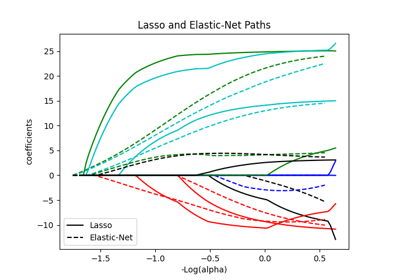sklearn.linear_model.enet_path#
- sklearn.linear_model.enet_path(X, y, *, l1_ratio=0.5, eps=0.001, n_alphas=100, alphas=None, precompute='auto', Xy=None, copy_X=True, coef_init=None, verbose=False, return_n_iter=False, positive=False, check_input=True, **params)[source]#
Compute elastic net path with coordinate descent.
The elastic net optimization function varies for mono and multi-outputs.
For mono-output tasks it is:
1 / (2 * n_samples) * ||y - Xw||^2_2 + alpha * l1_ratio * ||w||_1 + 0.5 * alpha * (1 - l1_ratio) * ||w||^2_2
For multi-output tasks it is:
(1 / (2 * n_samples)) * ||Y - XW||_Fro^2 + alpha * l1_ratio * ||W||_21 + 0.5 * alpha * (1 - l1_ratio) * ||W||_Fro^2
Where:
||W||_21 = \sum_i \sqrt{\sum_j w_{ij}^2}
i.e. the sum of norm of each row.
Read more in the User Guide.
- Parameters:
- X{array-like, sparse matrix} of shape (n_samples, n_features)
Training data. Pass directly as Fortran-contiguous data to avoid unnecessary memory duplication. If
yis mono-output thenXcan be sparse.- y{array-like, sparse matrix} of shape (n_samples,) or (n_samples, n_targets)
Target values.
- l1_ratiofloat, default=0.5
Number between 0 and 1 passed to elastic net (scaling between l1 and l2 penalties).
l1_ratio=1corresponds to the Lasso.- epsfloat, default=1e-3
Length of the path.
eps=1e-3means thatalpha_min / alpha_max = 1e-3.- n_alphasint, default=100
Number of alphas along the regularization path.
- alphasarray-like, default=None
List of alphas where to compute the models. If None alphas are set automatically.
- precompute‘auto’, bool or array-like of shape (n_features, n_features), default=’auto’
Whether to use a precomputed Gram matrix to speed up calculations. If set to
'auto'let us decide. The Gram matrix can also be passed as argument.- Xyarray-like of shape (n_features,) or (n_features, n_targets), default=None
Xy = np.dot(X.T, y) that can be precomputed. It is useful only when the Gram matrix is precomputed.
- copy_Xbool, default=True
If
True, X will be copied; else, it may be overwritten.- coef_initarray-like of shape (n_features, ), default=None
The initial values of the coefficients.
- verbosebool or int, default=False
Amount of verbosity.
- return_n_iterbool, default=False
Whether to return the number of iterations or not.
- positivebool, default=False
If set to True, forces coefficients to be positive. (Only allowed when
y.ndim == 1).- check_inputbool, default=True
If set to False, the input validation checks are skipped (including the Gram matrix when provided). It is assumed that they are handled by the caller.
- **paramskwargs
Keyword arguments passed to the coordinate descent solver.
- Returns:
- alphasndarray of shape (n_alphas,)
The alphas along the path where models are computed.
- coefsndarray of shape (n_features, n_alphas) or (n_targets, n_features, n_alphas)
Coefficients along the path.
- dual_gapsndarray of shape (n_alphas,)
The dual gaps at the end of the optimization for each alpha.
- n_iterslist of int
The number of iterations taken by the coordinate descent optimizer to reach the specified tolerance for each alpha. (Is returned when
return_n_iteris set to True).
See also
MultiTaskElasticNetMulti-task ElasticNet model trained with L1/L2 mixed-norm as regularizer.
MultiTaskElasticNetCVMulti-task L1/L2 ElasticNet with built-in cross-validation.
ElasticNetLinear regression with combined L1 and L2 priors as regularizer.
ElasticNetCVElastic Net model with iterative fitting along a regularization path.
Notes
For an example, see examples/linear_model/plot_lasso_coordinate_descent_path.py.

